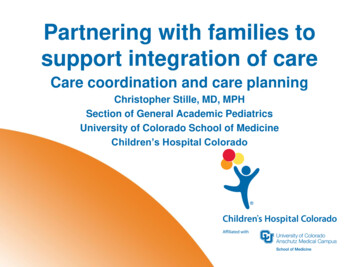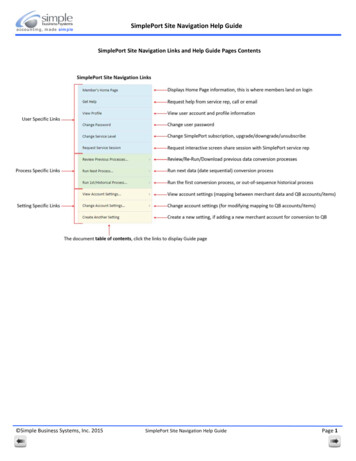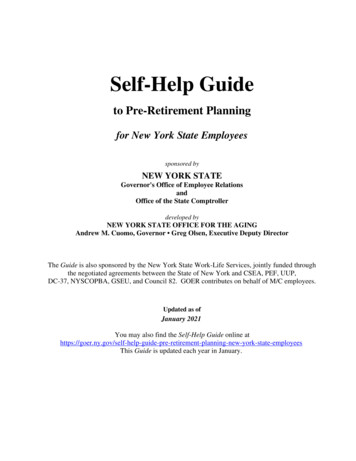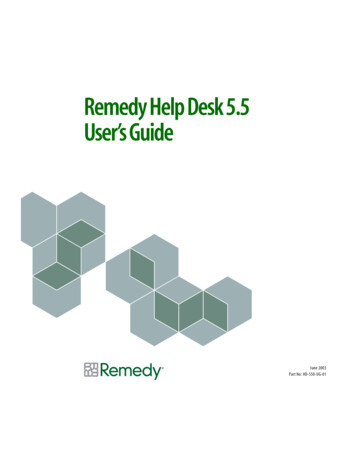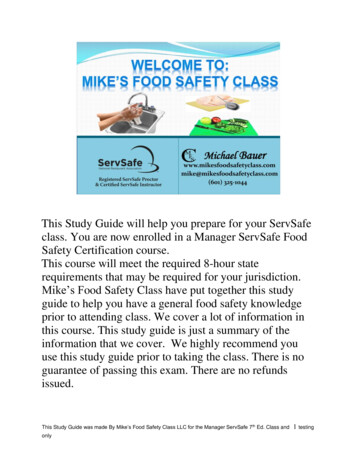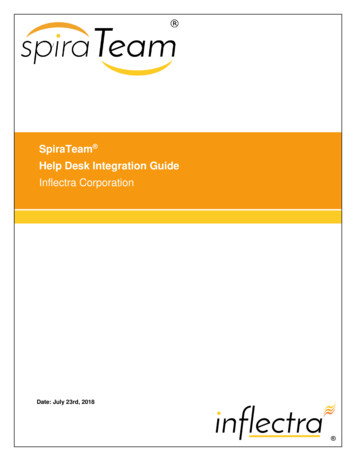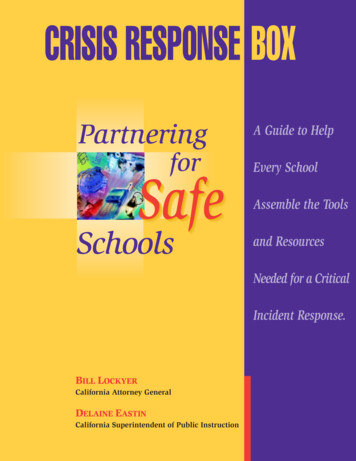
Transcription
PartneringforSafeSchoolsA Guide to HelpEvery SchoolAssemble the Toolsand ResourcesNeeded for a CriticalIncident Response.BILL LOCKYERCalifornia Attorney GeneralDELAINE EASTINCalifornia Superintendent of Public Instruction
ForewordForewordRecent tragedies on school campuses in Mount Morris Township, Michigan; Littleton, Colorado;and Conyers, Georgia raise serious concerns about school safety. School and law enforcementofficials involved in these tragedies reinforce one resounding message:It can happen to you.The Crisis Response Box is a guide to assist schools in crisisprevention planning. A strong crisis response strategy is designedto contain a crisis and thereby reduce the risk of violence or traumato students and school personnel. “The box” is a unique productof the California Attorney General and State Superintendent ofPublic Instruction’s Safe Schools Task Force, developed to help schools,local law enforcement and emergency services personnel prepare for a school emergency.The Crisis Response Box is an invaluable resource if a critical incident ever arises at yourschool. It walks you through the steps necessary to assemble a school emergency responseplan adapted for your school and community before an event occurs.School and law enforcement officials involved in most of the recent major school shootingincidents across the nation helped design this tool based on the lessons they learned.It includes what they wished they had had at their fingertips when crisis hit their schools.With this powerful tool, you will have at hand the information you need if an emergencystrikes – for maximum protection of students and staff and a swift recovery of the entireschool community.Comprehensive school crisis prevention planning includes assembling the box, coordinatingwith all those who will be involved if a crisis occurs, conducting practice drills and identifyingsecurity needs. The box, therefore, is designed to be both a process and a result. It consistsof bringing together school officials, law enforcement officers and emergency services personnelin the collaborative process required to meet your school’s disaster planning needs. And, itwill result in a tangible aid to gaining control of any school critical incident.We hope you never need to use the contents in a Crisis Response Box – but we also hope youhave one if you ever do face a crisis.BILL LOCKYERDELAINE EASTINAttorney GeneralState Superintendent of Public Instructionpage1
BackgroundBackgroundThe CrisisResponse Box hasone simple goal:schooladministrators willimmediatelyhave theinformationessential foreffectivemanagementof a majorcritical incident.In February 1999, the Attorney General and the State Superintendent of Public Instructionformed a 23-person Safe Schools Task Force, representing education, law enforcement,community groups and youth. The State Superintendent and Attorney General asked theTask Force members to identify ways to further address crime in our schools and createa more powerful partnership between schools and law enforcement to keep schools safeand free from violence. The Task Force members stressed, among other recommendations,that effective crisis response procedures are critical to enhanced school safety. The CrisisResponse Box is a product of the Safe Schools Task Force, designed to help you establisheffective emergency procedures.In response to the concerns of parents, students, school administrators and teachers, andspurred by incidents of violence on school campuses, the California Legislature enactedSenate Bill 187 (Chapter 736, Hughes, Statutes of 1997) that requires all California schoolsto develop and implement comprehensive Safe School Plans. (Education Code section35294.2) In addition, California requires that school principals formulate and submitto the district superintendent for approval a civil defense and disaster preparedness planfor that school. Principals must test that plan at least two times during the school year.(Education Code section 33031) The law also deems public employees to be disasterservice workers subject to such disaster service activities as may be assigned to them, andthat school districts have a responsibility to be as prepared as possible to meet emergencies.(California Government Code, Title 1, Division 4, Chapter 8, section 3100)The California Department of Education provides schools with guidelines and a planningprocess for safe school planning that meet the requirements of SB 187. This seven-stepprocess is detailed in the Department’s publication, Safe Schools: A Planning Guide forAction.1 The sixth step in the planning process directs schools to identify the strategiesthey will use to implement their plan. Among those strategies required by the law is thedevelopment of disaster and emergency response procedures. Assembling the contentsof the Crisis Response Box will augment what schools may have done in fulfilling thisvery important requirement. It does not, however, constitute a comprehensive Safe SchoolPlan required by Section 35294.2.The President’s National School Safety Council also recommends that schools develop acrisis management plan, including a contingency plan, for intervention during a crisis andin response to a tragedy.The Purpose of theCrisis Response BoxThe Crisis Response Box has one simple goal: school administrators will immediatelyhave the information essential for effective management of a major critical incident.A crisis is not the time to collect information – it is the time to act upon information.Precious minutes need not be lost gathering life-saving intelligence. Knowing whatinformation to collect ahead of time, how to organize it and how to use it during acrisis are all addressed through assembling the contents of the box.page2Purpose
ResearchResearch Behind theCrisis Response BoxThe Information YouNeed – In One Place“We found that organizing aThe State Superintendent of Public Instruction and Attorney General’sSafe Schools Task Force commissioned a study of the current best practices usedthroughout California and the country in preventing and responding to criticalincidents in schools. This project drew upon a number of valuable resources: Personal interviews with law enforcement officials who have responded to majorschool shooting incidents throughout the country Interviews with school superintendents and local law enforcement officials whohave developed mutual crisis or disaster procedures The results of a School Violence Summit called by the FBI Academy and theArkansas State Police that brought together law enforcement officers who hadbeen engaged in tragic critical incidents involving homicides at their local schools Existing crisis response procedures developed in partnership between schools,law enforcement and community response agencies From Chaos to Control: School Crisis Response2Those involved in such incidents were asked to answer these questions: “Knowingwhat you know today, what information would you have liked to have had to helpyou better manage the crisis?” “From your experience, what information shouldschool administrators and police officials have at their finger tips in a crisis?”Answers to these questions helped Safe Schools Task Force members to recommenda crisis response information inventory. Twenty critical pieces of information havebeen identified along with the procedures to gather the material, the rationale behindcollecting it and instructions on how to use it during a critical incident. All thisinformation is stored in the box. Thus, school administrators who use this toolwill benefit directly from the lessons learned by other schools whofaced critical incidents and from the insights of law enforcementofficers who responded to such crises.box . . . that contains crucialinformation we would need torespond to a critical incidentwas a great way for both theschools and the police to thinkthrough how they would worktogether in an actual crisis. Theprincipal, local police and localfire department have the samekit. Every summer we meet andreview the contents and updatethem.”Captain Terry RammellLa Habra Police DepartmentLa Habra, CaliforniaJoan MallardDirector of Special ProgramsLa Habra City School DistrictLa Habra, CaliforniaAll participants in this project made it clear: the informationneeded in a critical incident should be assembled ahead of time andcontained in one place; the information needs to be portable andeasily accessible in a crisis. It should be in a format enabling it to bequickly shared with first responders. School and community officialswho have reviewed the Crisis Response Box School Critical IncidentInformation Inventory welcome its simplicity as an organizing tool.1SafeSchools: A Planning Guide for Action (1995 Edition) was developed jointly by the CaliforniaDepartment of Education and the California Attorney General’s Crime and Violence Prevention Center.An Addendum to the Guide was published in 1998 in response to the passage of SB 187.Copies can be ordered by calling the California Department of Education at (916) 445-1260.2From Chaos to Control: School Crisis Response (1994), training materials produced by theCalifornia County Superintendents Educational Services Association in collaboration with theSchool/Law Enforcement Partnership and modeled after materials developed by crisis responsetrainer, Mary Schoenfeldt.page3
pen-endedcommunication with schooladministrators and lawenforcement officials musttake place while planning.Each must know what his orher individual responsibilityis and be comfortablewith it. A tragedy isnot the place to startdebating assignmentsor responsibilities orSchools should bring together the appropriate staff to review theSchool Critical Incident Information Inventory (see p. 14 and 15 )and identify who in the school or community will be responsiblefor gathering each specific item. The purpose of the Crisis ResponseBox is to quickly locate and provide relevant information to the rightpeople so they may begin responding. Each item on the InformationInventory is explained below. Following are overall suggestions tohelp you create your own Crisis Response Box.Bring together an interdisciplinary team to review the School Critical Incident InformationInventory checklist – including maintenance and grounds staff, local law enforcement,medical emergency response and fire officials. Be sure to coordinate the planningprocess with your local emergency response system. (See Integrating with your localIncident Command System, p. 11.)whose turf it is.Bill Slade, Chief of PolicePearl Police DepartmentPearl, MississippiA School Critical Incident Information Inventory is provided at the back of this guide.Begin by making copies of it to use as your work sheet for organizing the critical datayou will need to complete your box.As indicated on the Information Inventory checklist at the end of this guide, identifyone individual as the responsible party for each listed item.Under the date column on the checklist, enter the most recent date that the informationhas been reviewed and/or updated.SchoolCritical IncidentInformationInventoryPlace the Information Inventory checklist on the insidecover of the box and update it at least twice a year.Keep each information item within the Crisis Response Boxseparate. It is a good idea to place each in a clear plastic folder.Do not bind the various information items together. In a crisis, specificpeople will need information relevant to their tasks – you do not wantto use up time sorting through a notebook.Use the enclosed contents decals to clearly mark each item on the upperright- hand corner of the first page for quick identification and retrieval.Hold one individual accountable for maintenance of the box.More than one person should have knowledge of the location of, and accessto, the box, to ensure its prompt retrieval and implementation in a crisis. Asingle individual may not be at school when a crisis hits or may be sidelinedby events. At the same time, strict security of the contents must be maintainedat all times.page4
“One of the major problemswe faced at Columbine wasthe gridlock. With the crisisbeing covered live onCNN and local television,Store the information in a box or container clearly marked with the enclosed CrisisResponse Box decals. Duplicates of the box can also be given to the local schooldistrict office; local law enforcement agency; the local fire department; and otherlocal emergency services personnel. Be sure to have more than one box – one inthe office area and one or two in other locations in case the office is not accessible.parents, relatives and newscrews rushed to the scene.The roads couldn’t handlethe traffic. Even theAfter the incident, the entire critical response team should meet to debrief.Recommendations for improvement of future planning, performance and responsewill be based on this debriefing.time getting through.”Schools need to be prepared to provide activities for their school community evenafter the initial incident is resolved. Students and staff alike may need support asthey struggle to return to a sense of normalcy. A mental health support team shouldbe established to deal with the immediate and ongoing aftermath activities.Officer Joe SchallmoserDirector of Security ServicesJefferson County Public SchoolsLittleton, Coloradoambulances had a hardPlanning for an Emergencywith an Interdisciplinary TeamThe Standardized Emergency Management System (SEMS) is a nationally recognizedemergency operations plan that is adapted for large critical incidents where multi-agencyresponse is required. Schools are mandated to use SEMS and the Incident CommandSystem (ICS) as the organizing structure for their Crisis Response Plan. SEMS facilitatespriority-setting, interagency cooperation and the efficient flow of resources and information.SEMS establishes common standards of organization, procedures, communications andterminology among agencies. This unified command structure functions under the directionof the ICS and all agencies and organizations work together under this system to moreeffectively respond to any major critical incident. By adopting and utilizing this system,schools will respond to any critical incident with better communication and coordinationwith other responding agencies and organizations. (See Integrating with your local IncidentCommand System, p. 11.)EmergencyPlanningpage5
ComponentsComponents of theCrisis Response BoxThe Crisis Response Box contains more than directions to use in theevent of an emergency. The following components make possible athorough school and community response to a crisis:Aerial Photos of CampusAn aerial perspective of the campus and the surrounding area is very helpful to all agencies involvedin a critical incident, including police, fire and paramedic personnel. Your local municipality maybe able to provide you with an aerial photo of your school and surrounding campus.MapCrisis response planners need to review the traffic patterns and intersections that will beaffected in a major crisis. Through this process, you can identify locations where parents orguardians can retrieve their children after an incident and determine traffic safety issues yourschool and law enforcement will have to consider when directing youth to safe areas. Keepas many as 20 copies of the map available, preferably laminated, for emergency personnel.Establish an emergency traffic plan capable of protecting emergency response routes andaccommodating traffic and parking needs for parents, students and the media. The mapshould illustrate these planned routes as well as: The streets surrounding the school Intersections near the school Vacant lots near the school Location of major utilitiesCampus LayoutIt is important to maintain current, accurate blueprints, classroom layouts and floor plansof the building and grounds, including information about main leads for water, gas,electricity, cable, telephone, alarm and sprinkler systems, hazardous materials location,elevators and entrances. This information is extremely helpful, especially duringa “shelter-in-place” situation when students are safely locked in a classroom.Information should be available on the layout of the building, including roomnumbers and whether or not there is a phone, cable television, e-mail,computers or cell phones in the classroom. On the campus layout diagram,it is also helpful to highlight areas that could pose a possible threat,e.g., the chemistry lab, biology lab or any welding and wood shopareas that could also become a haven for weapons. It is also helpfulto show the location of the fire alarm turn-off, sprinkler systemturn-off, utility shut-off valves, cable television shut-off andfirst aid supply boxes. These items can be color-coded onthe campus layout.Blueprint of School BuildingsArchitectural blueprints of the school building(s) areimportant to a SWAT team, and provide additional – and moredetailed information – than the simple classroom layout diagram.This information may be critical, especially in the event of a bomb threat.The plant manager for the school site should be the custodian for theblueprints. Grounds and maintenance staff of the school should be familiarwith these blueprints and their location.page6
Teacher/Employee RosterA teacher/employee roster should go into the Crisis Response Box. If you can enter teachers’names on the classroom layout diagram, all the better. If not, be sure to match up eachteacher’s name with his or her classroom – and identify whether or not each teacher hasa cell or landphone. This roster should identify any teacher/employee with special medicalneeds (e.g., diabetes) who will require medications during a prolonged period and thosewith a disability who may require assistance in an evacuation. In a critical incident, someonein the front office should pick up the visitor/volunteer/substitute teacher list.hough cellularphones are an excellenttool, during the shootings atColumbine so many cell phonesKeysThe Crisis Response Box should also contain a master keyand an extra set of keys for those rooms for which amaster key cannot be used. The keys mustbe clearly tagged. Consider placing thekeys in a locked container within the box toassure added security in case the box should end up in the wronghands. Some schools have found it advantageous to keep the masterkey in a Knox box outside of the school. This is a secured metal boxthat can easily be accessed by a code or a key without having to enter thebuilding. This can prove especially helpful when it is not safe to enter the school. Furtherinformation on a Knox box can be obtained from your local fire department.Fire Alarm Turn-off ProceduresOne of the lessons learned from Columbine was to make it easier to turn off the alarm.The loud alarm made it very difficult for responders to hear directions. It took considerabletime before someone who knew how to turn it off was able to do so. School officialslearned that you can’t assume that the person who knows how to turn off the alarm willbe logistically able to do so. If that person is inside the building he or she might not beable to get to the shut-off valve; if that person is outside, it is possible that he or she mightnot be able to safely re-enter the school. As a result, a number of people need to knowhow to shut off the alarm. Providing such information on where shut-off valves are locatedin the building and the procedures for shut-off in the box could prove vital. In addition,though somewhat costly, some schools have installed a secure alarm shut-off systemoutside the school that can control the fire alarm and sprinklers.were being used in the area thatthe cell site became overloadedand shut down. During thatcrisis, some students resortedto computers to send e-mailmessages. Many schools areequipping themselves withphones that do not requiresatellite transmission andseveral nation
crisis management plan, including a contingency plan, for intervention during a crisis and in response to a tragedy. The Crisis Response Box has one simple goal: school administrators will immediately have the information essential for effective
